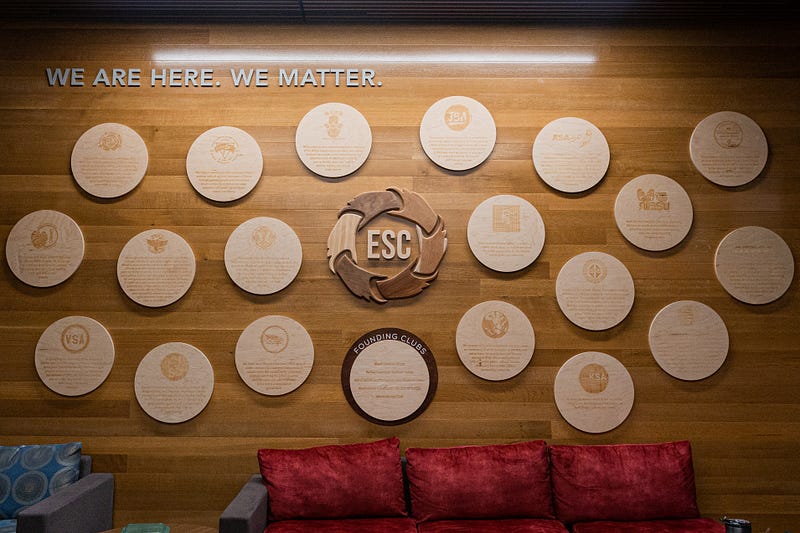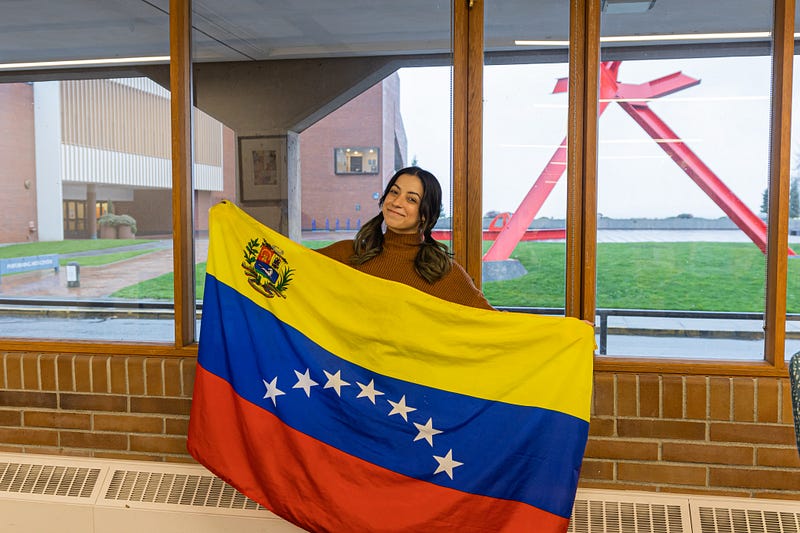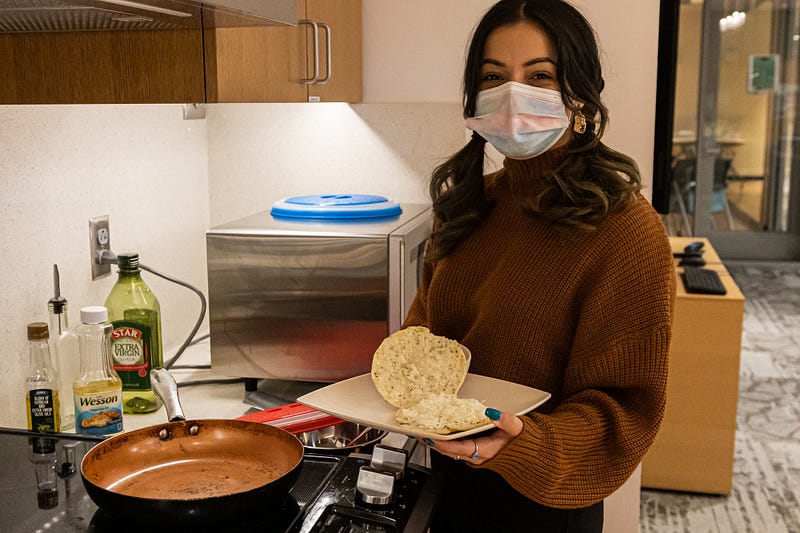Roadway to Success in the U.S.

Immigrant-origin students pursue the American dream.
Written by Adriannah Roman
On your journey to class, you stop for a second and look around. You realize that you’re a blur in a crowd full of white dominance.
“When you’re on a predominantly white campus, BIPOC students can sometimes feel hyper-visible and invisible at the same time,” says Melissa Uyesugi, assistant director for the Ethnic Student Center at Western Washington University. “Students often code-switch because they feel like they can’t be themselves in certain places and spaces.”
Some students associate themselves as being immigrants while others have a family history of immigration. Many students who fall under this immigrant-origin category, those who were born in the U.S. but are part of a family who immigrated, may experience hardships during their academic journey at Western.
Western has established an Ethnic Student Center for students with multicultural backgrounds to embed themselves in an inclusive atmosphere.
Western is home to thousands of students from all over the world. The university welcomes both documented and undocumented students while providing them with resources and services to support their academic and financial needs.
Demographically, Western enrolled 15,197 students in fall 2021, and of that number, 28.6% of students identify as being students of color.
The U.S. and education systems have been growing in diversity. In a 2020 research about immigrant-origin students in the U.S., Jeanne Batalova, a Senior Policy Analyst at MPI and Manager of the Migration Data Hub, says immigrant-origin students play an important role in postsecondary enrollment across the country. These students account for 58% of the growth of the student population between 2000 and 2018.
With more students identifying with the immigrant-origin population in the education system, our future workforce will continue to represent and reflect that growth.
Some immigrant-identifying students feel a sense of gratitude for attending a university in the U.S. since a higher-level education is harder to obtain in their home countries.
Amy Tuffour-Manu is a third-year Western student who immigrated from Wurzburg, Germany, in 2001. She obtained her citizenship status in the U.S. in 2002 alongside her mother, who was born in Ghana.
Tuffour-Manu says she is grateful to be in the U.S. as it offers her more options for education than Germany would have.
“There are more opportunities here, it’s the U.S. and that’s how it’s structured,” Amy said.

Tuffour-Manu is currently working towards a psychology major and anthropology minor, and she plans to graduate in spring 2023. Along with keeping up in academics, she is also the treasurer for the K-pop Dance Club on campus.
During club meetings, she brings out her funky dance moves and lets down her guard from being a student to a dancer. She fires every move with energy and excitement as she leads the rest of the group. Her ecstatic body movements are the result of hours of ongoing practicing.
Tuffour-Manu also works at the on-campus Starbucks. There, she approaches everyone with a cheerful smile and a positive attitude. What makes her stand out is the white, winged eyeliner that she puts on every day. After wearing the branded Starbucks uniform, it’s easy to blend in with everyone else, but her signature eyeliner helps cast her uniqueness a mile away.
With a hectic schedule, Tuffour-Manu learns to juggle her schedule and make room for fun hobbies such as enrolling in the K-pop Dance Club.
When it comes to finding ways to embed yourself in extracurricular activities, Western offers a wide variety of clubs to choose from. Whether it’s the K-pop Dance Club, Art club or a culturally-defined club, Western has it all. For students interested in joining clubs for comfort and a chance to meet others within their culture and ethnicity, Western offers 19 clubs that run through the Ethnic Student Center. The Chinese Student Association, Black Student Union and Latinx Student Union are a few examples of opportunities available for deeper connection within ethnic student communities. Students can join the present clubs or partner up to create a new one as there is an opportunity for new communities to be formed at any time.
The ESC strives to allow students within those ethnic groups to form an identity and feel recognized in a white-dominated community.
“The three things we try to do at the ESC are called our ABCs,” Uyesugi said. “We try to Affirm people’s identity, Build community and Cultivate leadership.”
Uyesugi began working with students and student leaders at the ESC in July 2021. “When I think about this role, this space and what it can do, I think back to when I was 20 when I first moved to Washington. I just needed a place and a space to feel like I belonged, where I could let my cultural hair down,” Uyesugi said with a warm smile. “If I can now be part of a center that does that for other young people, I’m happy to be able to do that.”
As an assistant director for the ESC, Uyesugi not only works with students in ESC clubs but also provides assistance and support to students at the Student Advocacy and Identity Resource Centers. Uyesugi wants to make sure every student regardless of race or ethnicity is treated equally.
“It makes this space more important because they don’t have to act, they don’t have to be someone different from who they are and can be in a space where their identities are centered,” Uyesugi said.
Steven Shetterly, a World Relief employee in Whatcom County, said he also enjoys working with students and families who are associated with refugee and immigrant backgrounds.
“It is always an enjoyable, life-giving experience to connect with people different from myself,” Shetterly said. “Many of them have lived through a whole lot and have insights and knowledge and a perspective on life that is vastly different from mine. I always learn a ton and am inspired by the stories of immigrants.”
Michelle Colman, a third-year at Western double majoring in acting and psychology, describes the ESC as a warm and welcoming atmosphere for students.
After immigrating from Venezuela in 2017, Colman appreciates the opportunity she has been given to attend Western as she fills her schedule with on-campus duties. As an officer for the SINI-HHA dance club, Colman has been able to connect and interact with students of similar interests. Colman is also support staff for the Disability Access Center and helps Washington Application for State Financial Aid students like herself who suffer from financial hardships due to citizenship status to obtain resources to help them with their academic needs. She said she enjoys working for the DAC and supporting students with similar difficulties.

Colman allowed me to see her in action at her workstation on the bottom floor of the Wilson Library. There she was hard at work, juggling dozens of papers. Students are allowed to stop by the DAC office and work on homework or ask for help. It was a warm, welcoming environment.
Moving to the U.S. at 16, Colman was met with several challenges alongside many positives. As a documented immigrant with no green card, Colman was not able to fill out the FAFSA and receive extra help for tuition. Because of that, she was also unable to attend her dream acting school in New York. Western was the only option that financially made sense to her, and luckily she was able to get some grants through WASFA.
“Although I’m not going to my dream school, I’m still grateful to have the opportunity to become ‘someone’ in the U.S., whereas I had no opportunity for advancement in my home country Venezuela,” Colman said. “I have things here that I didn’t have there, I have a car, education and a decent phone.”
As she is much happier to be in the U.S. than Venezuela, there are some Venezuelan cultural aspects she likes more than American culture. For example, Colman introduced me to a traditional-style Venezuelan dish, arepa Venezuelan.
“My mom makes arepas every morning for breakfast,” she said. “They are easy to make, all you need is a special flour, or harina pan, salt and water.”

It takes about 15 minutes to cook on the stovetop. They can be paired with meat, cheese, butter or really anything, says Colman. They can be eaten for breakfast, lunch, dinner or as a snack.
After trying an arepa, I was amazed. It was savory and full of flavor. The Venezuelan cheese gave it a nice, comforting feel.
“You will never meet a Venezuelan who hasn’t had an arepa,” Colman said. “Colombian and Venezuelans fight over the origin of arepas, but it’s definitely Venezuelan in my opinion, but I’m biased.”
Harina pan has been a quick on-the-go breakfast dish for Colman, but now and then she drops her cultural heritage and grabs Starbucks. And with a love for acting, Colman plans to embed herself in the “American dream” by moving to L.A. to fulfill her dream.
